Once upon a time, an unknown grad student in mathematics came up with these novel idea: What if, instead of having a board game, you played with cards instead? And what if you combined the strategy of this card game with the traditional idea of collecting baseball cards. A … collectible card game if you will. “Eureka!” he cried, and took to the streets naked in his excitement.
That man was Richard Garfield. The game was Magic: the Gathering. It was launched by Wizards of the Coast in 1993, and with the exception of a couple early hiccups, the game has never looked back. Now going into its 20th year it has with a few exceptions a lock on the CCG market. (Stay tuned for a future article on how the market has evolved responses to this.)
This could all be great if you’re a fan of Magic. But it wasn’t always so. There was a time before it was the behemoth it is that it shared valuable table space with sibling CCG games. Did you know that other collectible card games also existed at the same time and were also successful in their own right?
I give you the top 5 collectible card games that also existed in Magic’s formative years:
5. Babylon 5
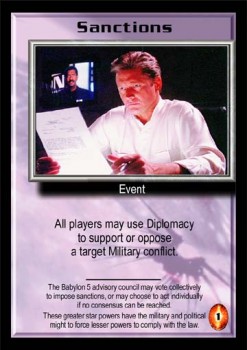 The 1990’s through early 2000’s were a golden age of remarkable sci-fi shows on tv. From the X-Files, to Farscape, to the way-too-short Firefly, to Stargate, to the pinnacle heights of the Star Trek franchise, you certainly had your share of well-done options. Plenty of these shows had games made out of them, but as usual, most of the time they fell short. Babylon 5 was the exception. The show is still regarded as one of the best-written shows on television, let alone science fiction. It had name recognition and spun out multiple game platforms.
The 1990’s through early 2000’s were a golden age of remarkable sci-fi shows on tv. From the X-Files, to Farscape, to the way-too-short Firefly, to Stargate, to the pinnacle heights of the Star Trek franchise, you certainly had your share of well-done options. Plenty of these shows had games made out of them, but as usual, most of the time they fell short. Babylon 5 was the exception. The show is still regarded as one of the best-written shows on television, let alone science fiction. It had name recognition and spun out multiple game platforms.
In addition to a moderately well-received tabletop, the Babylon 5 CCG was at heart a political game between the races. It was designed for multiplayer use, with each player representing one of the major races of the series (except the Vorlons; they refuse to be controlled). The nuanced intrigue and shifting diplomacy made players have to continually assess their alliances with one another while trying to advance their own agendas, and the first person to amass enough influence points wins. The game had several unique sets made over its 5-year lifespan, and another was in the making when the company lost the production rights in 2001. The company shuttered less than a year later as a result, which abruptly ended a game that had fairly decent sales for someone not Wizards of the Coast.
4. Vampire: The Eternal Struggle / Jyhad
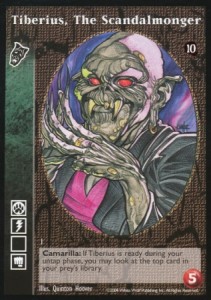 V:tES is set in the gothic horror “World of Darkness” universe created by White Wolf Publishing. Players are the avatars of various powerful and ancient vampires looking to eliminate the influence of other vampires. In the pre-Twilight era, vampires were still evil, manipulative and vicious. You know, a vampire. This game has that in droves, as while you can win through a variety of methods, attacking the player to your left was the most common. The game was created by none other than the same Richard Garfield of M:tG, and was also released initially by Wizards of the Coast. Striving to prove that the idea of a CCG was viable, this was his first game after Magic, and he made a number of mechanical changes. Namely, he wanted to increase the multiplayer aspect of it. Vampire delivered: its ideal number to play was 5.
V:tES is set in the gothic horror “World of Darkness” universe created by White Wolf Publishing. Players are the avatars of various powerful and ancient vampires looking to eliminate the influence of other vampires. In the pre-Twilight era, vampires were still evil, manipulative and vicious. You know, a vampire. This game has that in droves, as while you can win through a variety of methods, attacking the player to your left was the most common. The game was created by none other than the same Richard Garfield of M:tG, and was also released initially by Wizards of the Coast. Striving to prove that the idea of a CCG was viable, this was his first game after Magic, and he made a number of mechanical changes. Namely, he wanted to increase the multiplayer aspect of it. Vampire delivered: its ideal number to play was 5.
Market-wise though, it did not get off to a good start. When the game came out in 1994 – just a year after Magic – it was originally known as Jyhad. However, in 1995, it was changed as to not be confused with the concept of Islamic jihad – which caused them to reprint the entire first set less than a year after release. WotC abandoned it in 1996, but luckily it was resurrected by none other than White Wolf in 2000. Since then it had moderate success and numerous expansions before finally stopping in 2010, making it one of the longest and oldest CCGs.
3. Netrunner
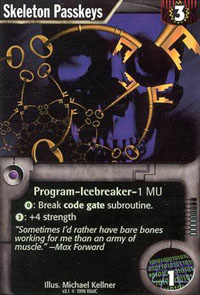 Yet another Richard Garfield creation. What can we say: the man could design card games. Netrunner was a two-player game set in a dystopian cyberpunk future. Borrowing influence from the Cyberpunk 2020 tabletop, one side played as an ominous mega-corporation trying to achieve their secret objectives. The other side played the hacker trying to get into the systems and steal precious data before that happens. There was a lot of back and forth as each side raced to win using very different card decks and tactics, which was unlike most CCGs where all cards are available to any given faction. While Magic may be Richard’s most impacting on the gaming world, many industry folks have often said that Netrunner was his best designed. Released in 1996 by – again – WotC, it only had one actual expansion. In 1996. A second “mini-expansion” came out in 1999 that released about 50 or so cards from an unfinished set. Aside from that it was another game that looked destined to be forgotten about save the die-hard fans due to Magic’s success.
Yet another Richard Garfield creation. What can we say: the man could design card games. Netrunner was a two-player game set in a dystopian cyberpunk future. Borrowing influence from the Cyberpunk 2020 tabletop, one side played as an ominous mega-corporation trying to achieve their secret objectives. The other side played the hacker trying to get into the systems and steal precious data before that happens. There was a lot of back and forth as each side raced to win using very different card decks and tactics, which was unlike most CCGs where all cards are available to any given faction. While Magic may be Richard’s most impacting on the gaming world, many industry folks have often said that Netrunner was his best designed. Released in 1996 by – again – WotC, it only had one actual expansion. In 1996. A second “mini-expansion” came out in 1999 that released about 50 or so cards from an unfinished set. Aside from that it was another game that looked destined to be forgotten about save the die-hard fans due to Magic’s success.
Luckily this story has a happy ending. In mid 2012, Fantasy Flight Games announced it would be relaunching Netrunner under it’s Android branding and changing the card release format from a CCG to it’s “LCG” line.
2. Star Wars Customizable Card Game
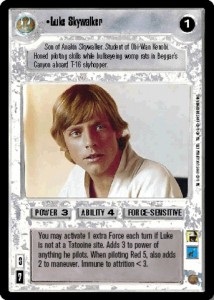 A Star Wars game? Who saw that coming? In the SW:CCG, players operated separate decks much like Netrunner. One player played as the Light Side and one player as the Dark Side, with one side defeating the other through use of a Magic-like mana system. The game was released by Decipher, who, capitalizing on their success of a Star Trek CCG, released Star Wars in 1996. It ran successfully until 2001, until a series of events caused its end. For one, in the late 90’s Decipher over-saturated its own market by launching two other Star Wars card games trying to capture some of the younger gamer market and to try to capitalize on the release of The Phantom Menace. (The Star Wars CCG only took place within the original trilogy.) Then it had a couple canceled expansions. Then at the end of 2001 it lost the Star Wars license to – of all people – Wizards of the Coast.
A Star Wars game? Who saw that coming? In the SW:CCG, players operated separate decks much like Netrunner. One player played as the Light Side and one player as the Dark Side, with one side defeating the other through use of a Magic-like mana system. The game was released by Decipher, who, capitalizing on their success of a Star Trek CCG, released Star Wars in 1996. It ran successfully until 2001, until a series of events caused its end. For one, in the late 90’s Decipher over-saturated its own market by launching two other Star Wars card games trying to capture some of the younger gamer market and to try to capitalize on the release of The Phantom Menace. (The Star Wars CCG only took place within the original trilogy.) Then it had a couple canceled expansions. Then at the end of 2001 it lost the Star Wars license to – of all people – Wizards of the Coast.
WotC went on to briefly make their own Star Wars trading card game made by (say it with me) Richard Garfield, but it never quite had the same success as Decipher’s. Unlike most other failed CCGs, however, the player base for Star Wars remained very active. Since 2001 and with the help of Decipher, a volunteer organization called the Player’s Committee has continued to create and print PDF sets and run tournaments. In fact, it was announced at the very beginning of 2013 that the Player’s Committee group is in the final stages of becoming a non-profit to continue support and promotion of the game – a game out of physical print for over 10 years. The Force is strong with them.
1. Legend of the Five Rings
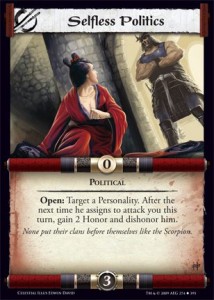 Legend of the Five Rings, or L5R, is another game that comes from a role-playing origin, but unlike the others, the same company controls both. It wasn’t always so, however.
Legend of the Five Rings, or L5R, is another game that comes from a role-playing origin, but unlike the others, the same company controls both. It wasn’t always so, however.
L5R (the CCG) was created in 1995 by Alderac Entertainment Group (AEG) and Isomedia. For a number of reasons related to marketing, promotion, etc., they spun off their creation into another single company. That company got itself brilliantly acquired in the same 1997 deal that gained Wizards of the Coast the rights to D&D. Are you sensing a pattern yet?
In 2001 AEG had to buy the rights back to its own game from WotC and has been publishing it on its own ever since. It exists as one of the only other CCGs that is as old as Magic and pretty successful in its own right.
In L5R, players portray a number of different clans of varying strengths and weaknesses. Much like other ones on this list, L5R is designed for multiplayer use. Much like Vampire, it also has multiple paths to victory. While divesting your opponent of their territories you can win by directly attacking them, but it’s just as common to win by reaching an Honor point total or collecting all five elemental rings.
Lastly, what makes it unique is that just like many of AEG’s product lines, how players participate in the L5R community with promotions and tournaments directly influences the storylines depicted in future expansions. That model, save for one unfortune event that helped caused the end of their 7th Sea line, has made AEG’s series of CCGs rather noteworthy among the gaming community. It continues to do well, far past the CCG wild west of the mid 1990s.
![]()
You can discuss this article over on our forums!
